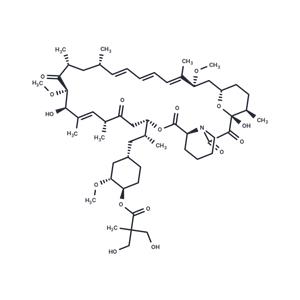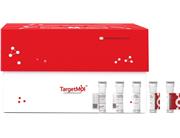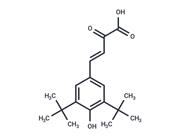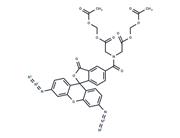| Name | Temsirolimus |
| Description | Temsirolimus (CCI-779) is a specific mTOR inhibitor ( IC50: 1.76 μM), used in the treatment of advanced renal cell cancer. |
| Cell Research | For all experiments, cells were plated in six-well plates in complete growth media for overnight. Various doses of CCI-779 or rapamycin analogs were added alone or with FK506 for indicated periods of time. Total cellular lysates were prepared using NuPAGE-LDS sample buffer. Equal amounts of proteins were subjected to immunoblotting analysis using NuPAGE electrophoresis system. Immunoblots were probed with appropriate primary and secondary antibodies following the manufacturer's instructions and detected using enhanced chemiluminescence. β-Actin immunoblotting and/or reversible Ponceau-S staining of nitrocellulose membranes after the transfer was used to visualize the total protein loading [1]. |
| Kinase Assay | The Flag-tagged wild-type human mTOR (Flag-mTOR) and Flag-mTOR-SI (S2035I, created by site-directed mutagenesis) DNA constructs were transiently transfected into HEK293 cells. Protein extraction and purification of Flag-mTOR and Flag-mTOR-SI were carried out 48 h later as described previously. In vitro kinase assays of purified Flag-mTOR and Flag-mTOR-SI without or with FKBP12 were done and detected by dissociation-enhanced lanthanide fluorescent immunoassay (DELFIA) as described [1]. |
| Animal Research | Mice bearing PC-3 tumors were treated with CCI-779 (1, 5, 10, and 20 mg per kg per day), or vehicle solution for 3 or 5 days per week for 3 weeks. Mice bearing DU145 tumors were only treated with CCI-779 (20 mg per kg per day) or vehicle solution for 3 weeks. Mice bearing PC-3 tumors received the following treatments: (a) control, vehicle solution for CCI-779; (b) chemotherapy alone, mitoxantrone 1.5 mg/kg or docetaxel 10 mg/kg was injected i.p. weekly for 3 doses; (c) CCI-779 alone, 5 or 10 mg/kg was injected i.p. daily, three times a week for 3 weeks; (4) chemotherapy followed by CCI-779. The largest and perpendicular diameters of tumors were measured twice weekly, and animals were coded using ear tags so that the observer was unaware of their treatment history. Tumor volume was estimated and plotted against time to evaluate response to treatment [2]. |
| In vitro | Temsirolimus (CCI-779; 10 nmol/L to <5 μmol/L) exhibited a generally flat and cell-selective inhibition of cell proliferation. The most sensitive cell lines that were inhibited by ≥50% included LNCap, PC3MM2, MDA468, H446, and Caco2, whereas those with ≤25% inhibition were SW480, HT29, HCT116, and H460 [1]. Following a 3-day exposure to 100 nmol/L CCI-779, the numbers of colony-forming PC-3 and DU145 cells were 0.18 ± 0.09 and 0.37 ± 0.03, respectively, compared with controls [2]. |
| In vivo | The growth of PC-3 tumors was inhibited by Temsirolimus in a dose-dependent manner and growth inhibition was greater than for DU145 tumors. Mean delay in growth to a volume of 500 mm3 was 39 ± 5 and 17 ± 3 days, respectively, following treatment with Temsirolimus (20 mg/kg i.p.) five times weekly for 3 weeks. Mice were randomized to treatment with 5 to 10 mg/kg/d of Temsirolimus or vehicle alone as a control [2]. Mice were treated 6 days per week. A statistically significant improvement in disease burden was seen in all samples tested. Mice xenografted from 3 of the patients (96, 240, and 359) had a statistically significant decrease in splenic disease bulk [3]. Temsirolimus, given as 10 intraperitoneal injections, induced significant dose-dependent, antitumor responses against subcutaneous growth of 8226, OPM-2, and U266 cell lines. Effective doses of Temsirolimus were associated with modest toxicity, inducing only transient thrombocytopenia and leukopenia. Although Temsirolimus-mediated inhibition of the p70 mTOR substrate was equal in 8226 and OPM-2 tumor nodules, OPM-2 tumor growth was considerably more sensitive to inhibition of proliferation, angiogenesis, and induction of apoptosis [4]. |
| Storage | Powder: -20°C for 3 years | In solvent: -80°C for 1 year | Shipping with blue ice. |
| Solubility Information | H2O : < 1 mg/mL (insoluble or slightly soluble)
Ethanol : 70 mg/mL (67.9 mM)
|
| Keywords | Temsirolimus | NSC-683864 | NSC683864 | mTOR | Mammalian target of Rapamycin | Inhibitor | inhibit | CCI779 | CCI 779 | Autophagy | Apoptosis |
| Inhibitors Related | Stavudine | Sodium 4-phenylbutyrate | L-Ascorbic acid | Hydroxychloroquine | Guanidine hydrochloride | Tributyrin | Paeonol | Naringin |
| Related Compound Libraries | Kinase Inhibitor Library | Anti-Cancer Clinical Compound Library | Drug Repurposing Compound Library | Inhibitor Library | FDA-Approved Drug Library | Anti-Cancer Approved Drug Library | FDA-Approved Kinase Inhibitor Library | Anti-Aging Compound Library | Bioactive Compounds Library Max | Anti-Cancer Drug Library |

 United States
United States



